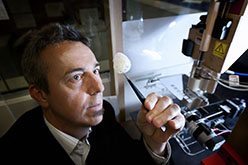Researchers at the Queensland University of Technology have made a major breakthrough in the field of 3D bioprinting.
According to an article published in Nature Communications, the biomedical engineers were able to 3D print scaffolds for the reinforcement of soft hydrogels used in tissue engineering. Professor Dietmar W. Hutmacher from the university’s Institute of Helath and Biomedical Innovation, explained that nature often uses fibre reinforcement in order to turn weak structures into mechanically robust ones. This is for example the case in articular cartilage tissue, formed by strong and stiff collagen fibres and a weak gel matrix of proteoglycans.
“By bringing this natural design perspective of fibre reinforcement into the field of tissue engineering (TE), we can learn a lot about how to choose an effective combination of matrix and reinforcement structure in order to achieve composite materials with enhanced mechanical properties for engineering body parts,” Hutmacher said.
Their international research team found a way to reinforce soft hydrogels, that are commonly used for tissue regeneration, by 3D printing a scaffold structure. The new technique used is called “melt electrospinning writing” and allows for the ultimate creation of fibre reinforced hydrogel structures with an increased stiffness of 54 times.
These 3D printed microfibres can be used in different hydrogels as well as in a wide range of tissue engineering applications, according to computational modelling.
Subscribe to our Newsletter
3DPresso is a weekly newsletter that links to the most exciting global stories from the 3D printing and additive manufacturing industry.





















